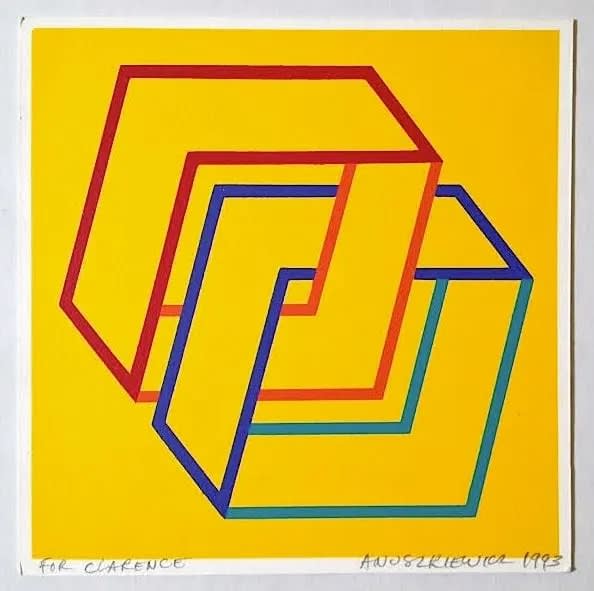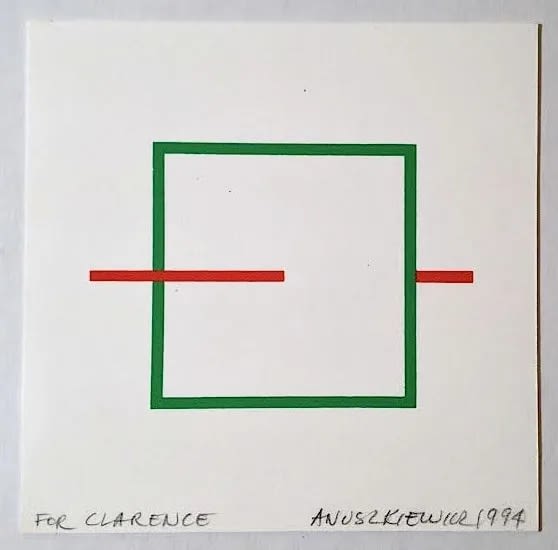I’m interested in making something romantic out of a very, very mechanistic geometry. Geometry and color represent to me an idealized, classical place that’s very clear and very pure.
– Richard Anuszkiewicz
The life of Richard Anuszkiewicz (1930-2020) took an unexpected turn in 1953. He had completed his BA degree at the Cleveland Institute of Art and used a Pulitzer Traveling Scholarship, not to travel, but to continue his study of art at Yale, where Josef Albers, who was head of the graphic design program, had a profound influence on Anuszkiewicz's career.
Anuszkiewicz had always been a fine, traditional artist. Meeting Albers, whose focus was on the study and interaction of colors, did not have an immediate impact on Anuszkiewicz. He completed his master’s in fine arts in 1955 and then went to Kent State to earn a bachelor’s in education.
It was then, away from Albers, that Anuszkiewicz changed from his traditional, realistic style to abstract works that focused on color and line. “Now that I was no longer fighting the strong Albers image, I was able to fully accept all this wonderful knowledge that I acquired without any prejudice,” he said in an interview for the Guggenheim Museum in the 1970s, “and instead of going back to realism, I went completely in the opposite direction.”
Anuszkiewicz moved to New York in 1957. He got a job at the Met but couldn’t find a gallery to show his work.
In 1959 he had his first solo show at the Contemporaries gallery in Manhattan. Nothing sold for the first two weeks. Then, enter Alfred H. Barr, the founding director of MoMA. Barr bought two paintings (one for the museum and one for then New York Governor Nelson Rockefeller) and the successful career of Richard Anuszkiewicz began.
He was commissioned by Barr to create a Christmas card for MoMA in 1963 and there was a waiting list for his work after it was featured in MoMA’s The Responsive Eye exhibition that focused entirely on Op Art.
Several versions of Anuszkiewicz’s Annual Edition cards, which he made for friends and family, are available at VFA.
We don't make mistakes. We just have happy accidents.
– Bob Ross
If you ever want to learn to paint, or never wanted to learn to paint, watching Bob Ross (1942-1995) is the way to go.
Bob Ross’s The Joy of Painting aired on PBS from 1983 through 1984. It ran for 31 seasons, with 403 episodes produced. He would make three versions of each painting for the show: one to work from while filming the show, the one he painted during the show and one after the show for use in instructional materials.
Bob Ross’s popularity has not waned, and has even increased since since old episodes began streaming on line. Some of his paintings are at the Smithsonian, many are stored at the Bob Ross, Inc. company and others in homes around the country.
A Walk in the Woods, the painting that Bob Ross made on the first episode of The Joy of Painting is now for sale at the Modern Artifact Gallery in Minneapolis, Minnesota. The asking price is $9.85 million. The painting is signed "Ross" in red on the lower left corner. Whoever buys the painting will receive a written statement from its original owner - a PBS volunteer who bought it at a benefit auction.
References:
Jillian Steinhauer. Richard Anuszkiewicz, Whose Op Art Caught Eyes in the ’60s, Dies at 89. The New York Times. May 25, 2020.
Oral history interview with Richard Anuszkiewicz, 1971 December 28 - 1972 January 7. Archives of American Art, Smithsonian Institution.
Charles Darwent. Richard Anuszkiewicz Obituary. The Guardian. May 29, 2020.
Cathy Wurzer. Gracie Stockton. Minneapolis gallery selling first Bob Ross painting from PBS show for $9.85 million. MPR News. September 26, 2023.
Rhea Nayyar. Bob Ross’s First On-Air Painting Could Fetch Nearly $10M. Hyperallergic. September 18, 2023.
Emily Olson. This rare Bob Ross painting could be yours — for close to $10 million. NPR. September 19, 2023.




